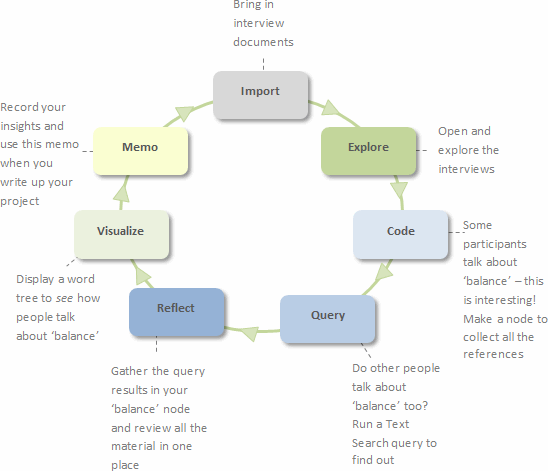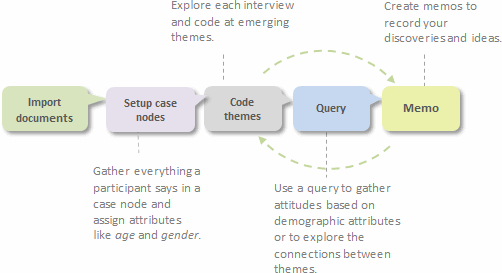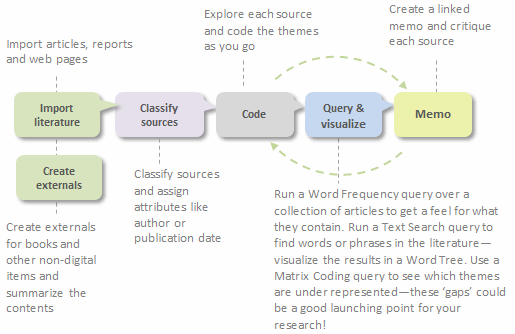|
|
Using NVivo for qualitative research
This topic discusses the process of qualitative research and describes different approaches you can take using NVivo.
In this topic
- What is qualitative research?
- Qualitative research as an iterative process
- How do I choose the best approach for my project?
- Ways to get started with your project
- Working toward outcomes that are robust and transparent
What is qualitative research?
Qualitative researchers are interested in evaluating, interpreting and explaining social phenomena. They analyze unstructured or semi-structured data like interviews, field notes, audio visual material and journal articles—and they work in a range of sectors; from social science and education to healthcare and business.
Researchers usually adopt a qualitative methodology to suit their research question. For example, a social scientist wanting to develop new concepts or theories may take a ‘grounded theory’ approach. A researcher looking for ways to improve health policy or program design might use ‘evaluation methods’. NVivo doesn’t favor a particular methodology—it’s designed to facilitate common qualitative techniques no matter what method you use.
Remember that NVivo can help you to manage, explore and find patterns in your data but it cannot replace your analytical expertise.
Qualitative research as an iterative process
Handling qualitative data is not usually a step-by-step process (first import, then code, then query, then interpret and then write-up). Instead, it tends to be an iterative process where you explore, code, reflect, memo, code some more, query and so on. For example, this illustration shows a path you might take to investigate an interesting theme:

How do I choose the best approach for my project?
Every research project is unique—the way you organize and analyze the material depends on your methodology, data and research design.
Below are some scenarios for handling different types of projects—these are just suggestions to get you up and running (feel free to share your own ideas and strategies on the QSR Forum):
- A study exploring community perceptions about climate change—working with consistently formatted interviews (where each participant is asked the same set of questions).

-
A literature review on adolescent depression—working with journal articles, books and web pages:

Ways to get started with your project
Since projects (and researchers) are unique there is no one 'best practice' approach to organizing and analyzing your data but there are some useful strategies to help you get up and running:
-
Start now - don't wait until you have collected all the data. Import your research design, grant application or thesis proposal.
-
Make a project journal and state your research questions and record your goals. Why are you doing the project? What is it about? What do you expect to find and why? What biases do you bring to the project? Update the journal regularly to stay focused and to show the evolution of your project.
-
Make a mind map for your preliminary ideas. Show the relationships or patterns you expect to find in your data based on prior experience or preliminary reading.
-
Import your interviews, field notes, focus groups —organize these sources into folders for easy access.
-
Set up an initial node structure based on your early reading and ideas—you could run a Word Frequency query over your data to tease out the common themes for creating your node structure.
-
Set up nodes for the people, places or other cases in your project.
-
Explore your material and code themes as they emerge—create memos and describe your discoveries and interpretations.
-
To protect your work, get in the habit of making regular back-ups.
-
Let yourself be informed, redirected and surprised by your data.
Working toward outcomes that are robust and transparent
Qualitative researchers are often called upon to demonstrate the credibility of their findings—NVivo can help in the following ways:
-
Was an issue or theme reported by more than one participant? Run a Matrix Coding query to see how many participants talked about a theme.
-
Were multiple methods used to collect the data (interviews, observations, surveys)—and are the findings supported across these data sources? Run a Matrix Coding query to see how often a theme is reported across all your sources

Using NVivo to organize and analyze your data also increases the 'transparency' of your research outcomes—for example, you can:
-
Demonstrate the evolution of your ideas in memos.
-
Document your early preconceptions and biases in a memo and demonstrate how these have been acknowledged and tested.
-
Easily find illustrative quotes.
-
Always return to the original context of your coded material.
-
Save and revisit the queries that helped you to arrive at your conclusions.



